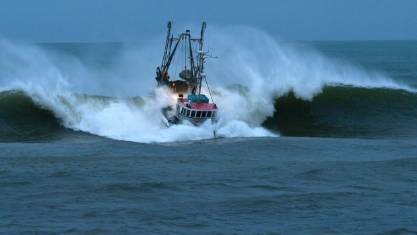…. And their dangers!
Crossing a coastal bar can be an easy task or it can be one of the most dangerous parts of a voyage so by ensuring you have the knowledge and having a sound procedure in place minimises the dangers!

Coastal bars build up at the entrance to costal rivers and are formed by the movement of sand and sediments. They cause waves to become steeper and often break as they approach the bar. Bars can change quickly and without warning making any crossing potentially dangerous!
Any crossing of a coastal bar can be a dangerous event EVEN when it appears calm.
Bars can produce dangerous waves that have the potential cause injury or loss of life and severe damage to or loss of vessels.
All bars are different and remember that slow displacement vessels handle bars differently than high speed planning vessels do.
The vessel must match the energy of each incoming wave by maintaining a speed that will lift the bow over the wave and reduce the chance of the wave breaking over the bow into the vessel.
Do not hit waves at high speed but take them as close to head-on as possible. Be prepared to take a wave head-on and take water over the bow if there is no other way.
A guideline for you when crossing a bar:
When coming in, high-speed boats (capable of at least 18 knots) should travel at the same speed as the waves.
Slow displacement boats may have to come in very slowly to avoid surfing and getting caught side-on to a wave.
Try to travel in on the back of a wave and stay ahead of waves that break behind the boat. Watch for patterns and deeper areas.
When returning over a bar you should:
In bad conditions, it can be safer to stand off in deeper water, or find another shelter, instead of attempting to cross the bar.
If you’re operating a passenger vessel and carrying passengers when crossing a coastal bar, it’s critical that you notify all passengers that you are about to cross a bar.
Remember to take into account lifejacket requirements, especially given the recent revision of Marine Order 504. You need to undertake a Risk Assessment to determine whether passengers need to wear a lifejacket.
In all but calm weather advise them to be seated and hold on until advised the bar crossing has been completed. When the bar crossing has been completed advise passengers that the bar crossing has been completed.
Never, at any time allow passenger on the bow area when crossing a coastal bar!
We strongly recommend that when crossing a bar everyone should wear a lifejacket taking into account the changes within Marine Order 504.
No matter the size of your vessel there is always the potential for capsize, especially on rough days! Remember putting a lifejacket on in the water is difficult but putting one in in rough seas is almost impossible!
Choose your route carefully and once you have started keep going as attempting to turn around in front of an incoming wave is dangerous.
Given the recent revision of Marine Order 504, it is imperative that you have wearing of life jackets in the Risk Register and a Procedure in your daily operations section. If you are unsure, contact our office today and we can assess your SMS and advise of changes required.
Our vital tips for crossing coastal bars……